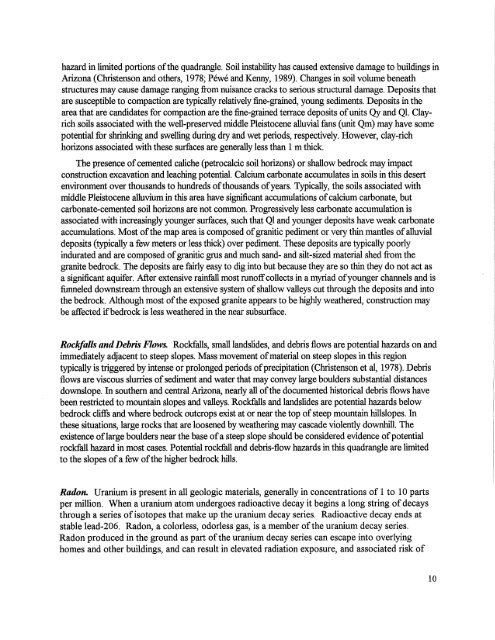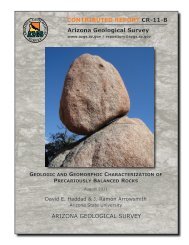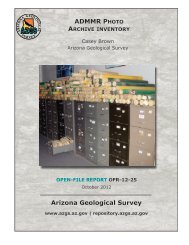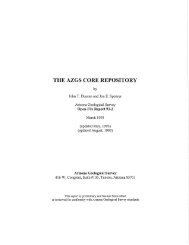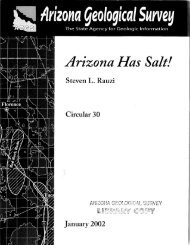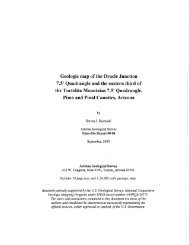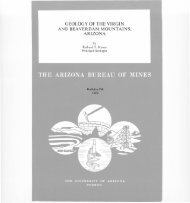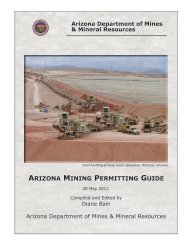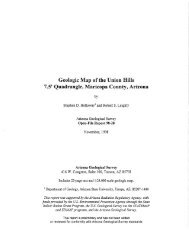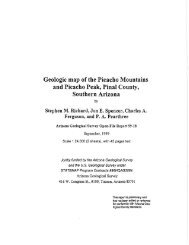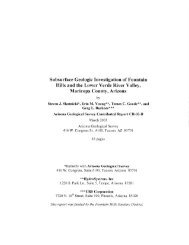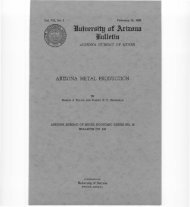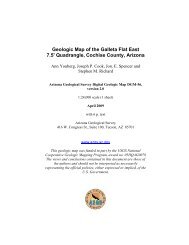Geologic Map of the Wildcat Hill Quadrangle, Maricopa County ...
Geologic Map of the Wildcat Hill Quadrangle, Maricopa County ...
Geologic Map of the Wildcat Hill Quadrangle, Maricopa County ...
You also want an ePaper? Increase the reach of your titles
YUMPU automatically turns print PDFs into web optimized ePapers that Google loves.
hazard in limited portions <strong>of</strong> <strong>the</strong> quadrangle. Soil instability has caused extensive damage to buildings in<br />
Arizona (Christenson and o<strong>the</strong>rs, 1978; Pewe and Kenny, 1989). Changes in soil volume beneath<br />
structures may cause damage ranging from nuisance cracks to serious structural damage. Deposits that<br />
are susceptible to compaction are typically relatively fine-grained, young sediments. Deposits in <strong>the</strong><br />
area that are candidates for compaction are <strong>the</strong> fine-grained terrace deposits <strong>of</strong> units Qyand Ql. Clayrich<br />
soils associated with <strong>the</strong> well-preserved middle Pleistocene alluvial fans (unit Qm) may have some<br />
potential for shrinking and swelling during dry and wet periods, respectively. However, clay-rich<br />
horizons associated with <strong>the</strong>se surfaces are generally less than 1 m thick.<br />
The presence <strong>of</strong> cemented caliche (petrocalcic soil horizons) or shallow bedrock may impact<br />
construction excavation and leaching potential. Calcium carbonate accumulates in soils in this desert<br />
environment over thousands to hundreds <strong>of</strong> thousands <strong>of</strong> years. Typically, <strong>the</strong> soils associated with<br />
middle Pleistocene alluvium in this area have significant accumulations <strong>of</strong> calcium carbonate, but<br />
carbonate-cemented soil horizons are not common. Progressively less carbonate accumulation is<br />
associated with increasingly younger surfaces, such that Ql and younger deposits have weak carbonate<br />
accumulations. Most <strong>of</strong> <strong>the</strong> map area is composed <strong>of</strong> granitic pediment or very thin mantles <strong>of</strong> alluvial<br />
deposits (typically a few meters or less thick) over pediment. These deposits are typically poorly<br />
indurated and are composed <strong>of</strong> granitic grus and much sand- and silt-sized material shed from <strong>the</strong><br />
granite bedrock. The deposits are fairly easy to dig into but because <strong>the</strong>y are so thin <strong>the</strong>y do not act as<br />
a significant aquifer. After extensive rainfall most run<strong>of</strong>f collects in a myriad <strong>of</strong> younger channels and is<br />
funneled downstream through an extensive system <strong>of</strong> shallow valleys cut through <strong>the</strong> deposits and into<br />
<strong>the</strong> bedrock. Although most <strong>of</strong> <strong>the</strong> exposed granite appears to be highly wea<strong>the</strong>red, construction may<br />
be affected ifbedrock is less wea<strong>the</strong>red in <strong>the</strong> near subsUlface.<br />
Rockfalls and Debris Flows. Rockfalls, small landslides, and debris flows are potential hazards on and<br />
immediately adjacent to steep slopes. Mass movement <strong>of</strong> material on steep slopes in this region<br />
typically is triggered by intense or prolonged periods <strong>of</strong> precipitation (Christenson et al, 1978). Debris<br />
flows are viscous slurries <strong>of</strong> sediment and water that may convey large boulders substantial distances<br />
downslope. In sou<strong>the</strong>rn and central Arizona, nearly all <strong>of</strong> <strong>the</strong> documented historical debris flows have<br />
been restricted to mountain slopes and valleys. Rockfalls and landslides are potential hazards below<br />
bedrock cliffs and where bedrock outcrops exist at or near <strong>the</strong> top <strong>of</strong> steep mountain hillslopes. In<br />
<strong>the</strong>se situations, large rocks that are loosened by wea<strong>the</strong>ring may cascade violently downhill. The<br />
existence <strong>of</strong> large boulders near <strong>the</strong> base <strong>of</strong> a steep slope should be considered evidence <strong>of</strong> potential<br />
rockfall hazard in most cases. Potential rockfall and debris-flow hazards in this quadrangle are limited<br />
to <strong>the</strong> slopes <strong>of</strong> a few <strong>of</strong> <strong>the</strong> higher bedrock hills.<br />
Radon. Uranium is present in all geologic materials, generally in concentrations <strong>of</strong> 1 to 10 parts<br />
per million. When a uranium atom undergoes radioactive decay it begins a long string <strong>of</strong> decays<br />
through a series <strong>of</strong> isotopes that make up <strong>the</strong> uranium decay series. Radioactive decay ends at<br />
stable lead-206. Radon, a colorless, odorless gas, is a member <strong>of</strong> <strong>the</strong> uranium decay series.<br />
Radon produced in <strong>the</strong> ground as part <strong>of</strong> <strong>the</strong> uranium decay series can escape into overlying<br />
homes and o<strong>the</strong>r buildings, and can result in elevated radiation exposure, and associated risk <strong>of</strong><br />
10


